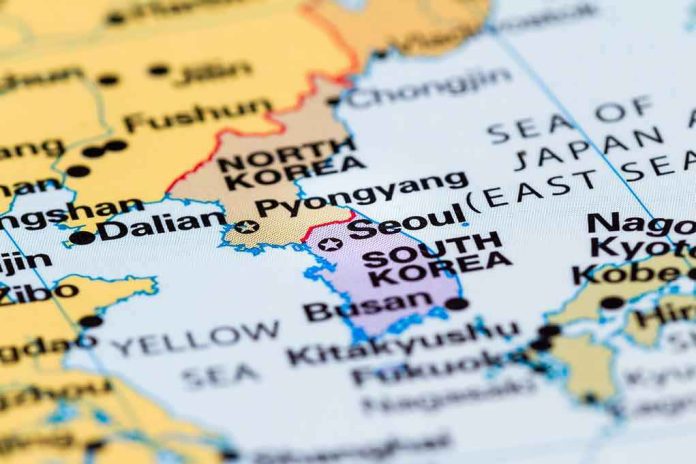
North Korea’s latest missile launches just days before President Trump’s arrival in South Korea send a chilling reminder of the threats facing American interests and allies while global leaders gather under heightened tension.
Story Highlights
- North Korea fires multiple ballistic missiles ahead of APEC summit, showcasing new Hwasong-20 ICBM technology.
- Launch comes days before President Trump’s high-stakes visit, testing U.S. resolve and diplomatic strategy.
- Pattern of provocative acts by Kim Jong Un aims to destabilize the region and challenge American leadership.
- Regional security and conservative values face renewed threats as global adversaries exploit perceived U.S. vulnerability.
North Korea Escalates Tensions Before Trump’s Arrival
On October 22, 2025, North Korea launched several short-range ballistic missiles toward the East Sea, marking its first missile test in five months. This action, orchestrated just days ahead of the APEC summit in Gyeongju, South Korea, coincides with President Trump’s Asia tour—a calculated move by Kim Jong Un to draw global attention and apply pressure on the United States and its allies. The timing highlights a familiar pattern: Pyongyang leverages high-profile diplomatic events to assert its nuclear ambitions and test Western resolve.
South Korea and Japan, both close U.S. allies and hosts to American military forces, immediately condemned the launches and stepped up military readiness. The missiles reportedly flew approximately 350 kilometers, demonstrating advancements in North Korean missile technology with the unveiling of the Hwasong-20 ICBM. These developments not only threaten the safety of millions in the region but also serve as a direct challenge to conservative priorities such as peace through strength, national security, and the defense of American interests abroad.
Diplomatic Stakes Rise as Trump Returns to the World Stage
President Trump’s visit to Asia, including key stops in Malaysia, Japan, and South Korea, comes at a critical juncture for American foreign policy. The APEC summit, attended by world leaders such as Xi Jinping and regional heads of state, is now overshadowed by North Korea’s provocative actions. Historically, Kim Jong Un has timed missile launches to coincide with major political summits or U.S. presidential visits, exploiting moments of global focus to extract concessions or sow discord among U.S. allies. This aggressive posturing is a stark reminder of the dangers posed by adversaries emboldened during prior periods of perceived American weakness.
In response, U.S., South Korean, and Japanese militaries have heightened their readiness, sending a clear message that any threats to regional stability will meet swift resistance. Trump’s return to the international arena, after years marked by leftist appeasement and globalist drift, signals a renewed commitment to assertive American leadership—backed by conservative principles of national sovereignty and a robust defense posture.
Regional and Global Implications for U.S. Security
The immediate impact of North Korea’s missile launches is an escalation of regional tensions and an increased risk of destabilization during a major diplomatic event. Economic markets in East Asia have reacted with volatility, while civilians in South Korea and Japan face renewed anxiety over security. In the longer term, these provocations reinforce the necessity of strong U.S. alliances and unwavering commitment to missile defense and deterrence. They underscore the failures of past appeasement strategies and highlight the urgency of standing firm against regimes that threaten American values and global order.
For conservatives and patriots, this episode is a clear call to vigilance. The U.S. must never allow adversaries to undermine constitutional principles, erode national security, or exploit moments of transition. The coordinated response from the Trump administration and allied governments demonstrates that the era of apologies and capitulation is over—America stands ready to defend freedom and uphold peace through strength.
Expert Analysis: North Korea’s Tactics and the Path Forward
Analysts agree that North Korea’s timing is no accident. By launching missiles during a high-profile summit, Kim Jong Un seeks maximum leverage without risking direct conflict. Experts warn that Pyongyang’s enhancements in missile technology signal continued advancement and a persistent threat to regional and U.S. security. Commentators note the cyclical nature of these provocations, emphasizing the challenge of achieving lasting denuclearization and the importance of U.S. resolve. Ultimately, this incident reminds Americans that global adversaries will exploit any perceived weakness—and that only steadfast leadership and conservative values can safeguard the nation’s future.
Sources:
North Korea fires short-range ballistic missiles as Trump prepares for summit in South Korea
North Korea rattles region with ballistic missile launch ahead of Trump’s Asia visit





